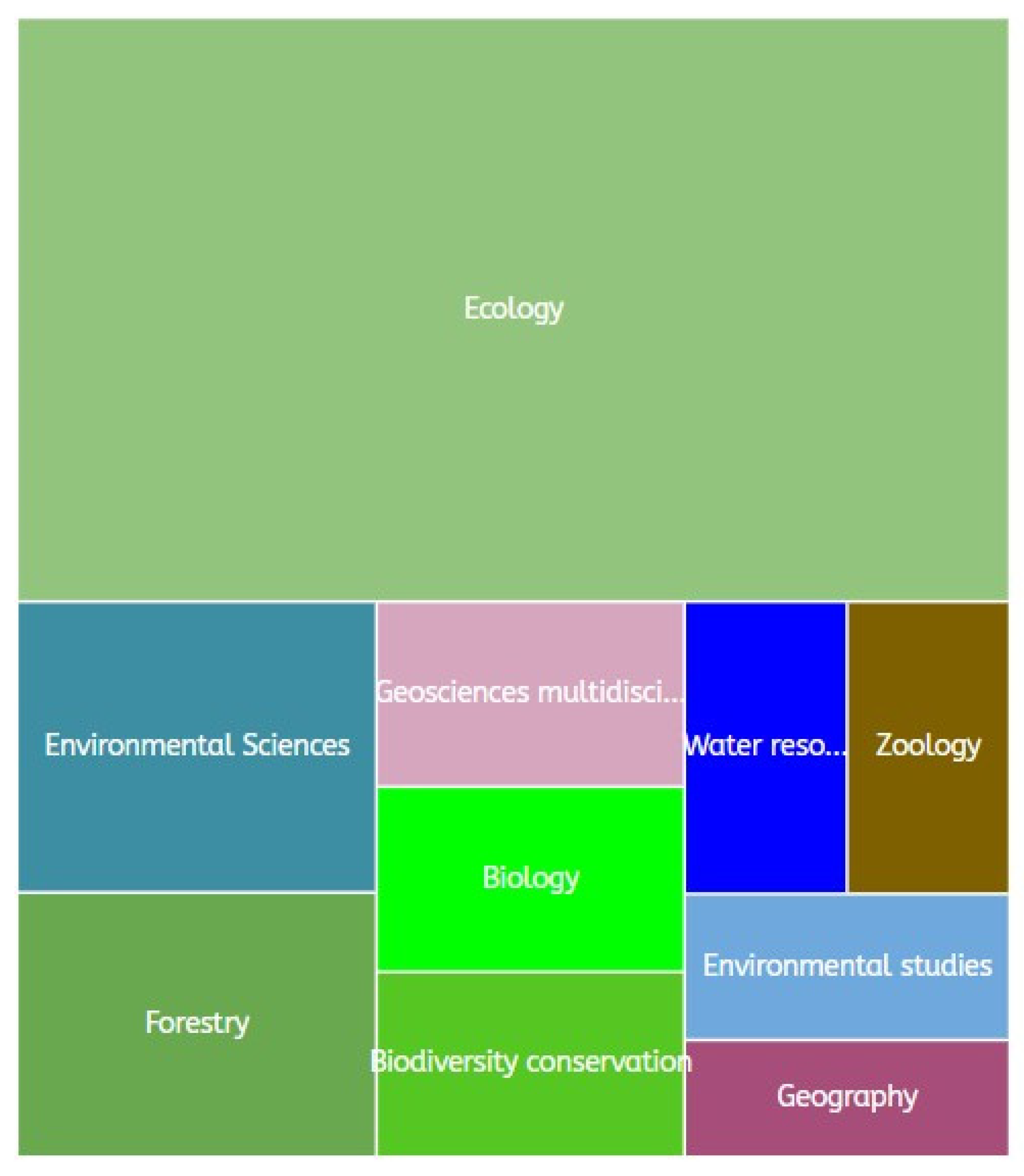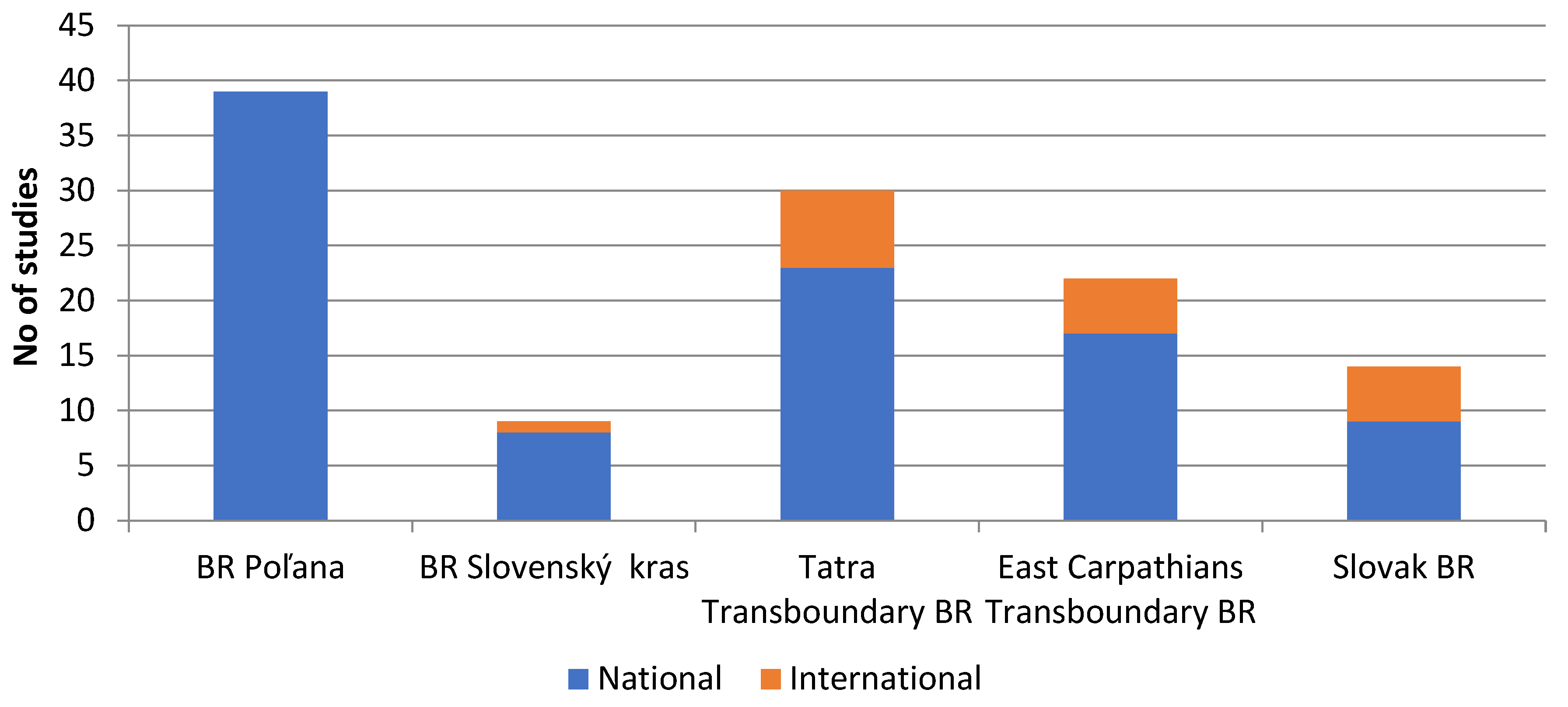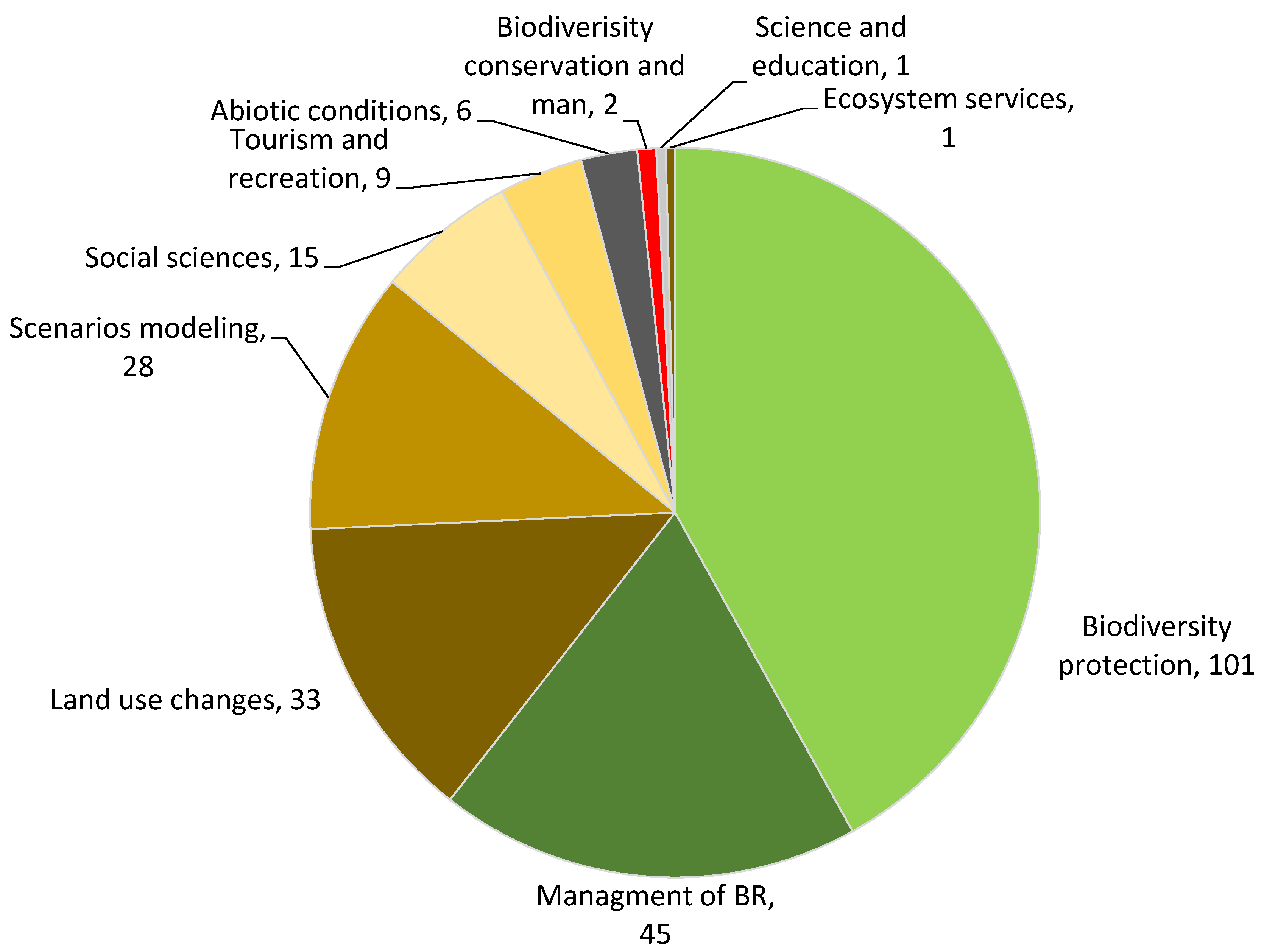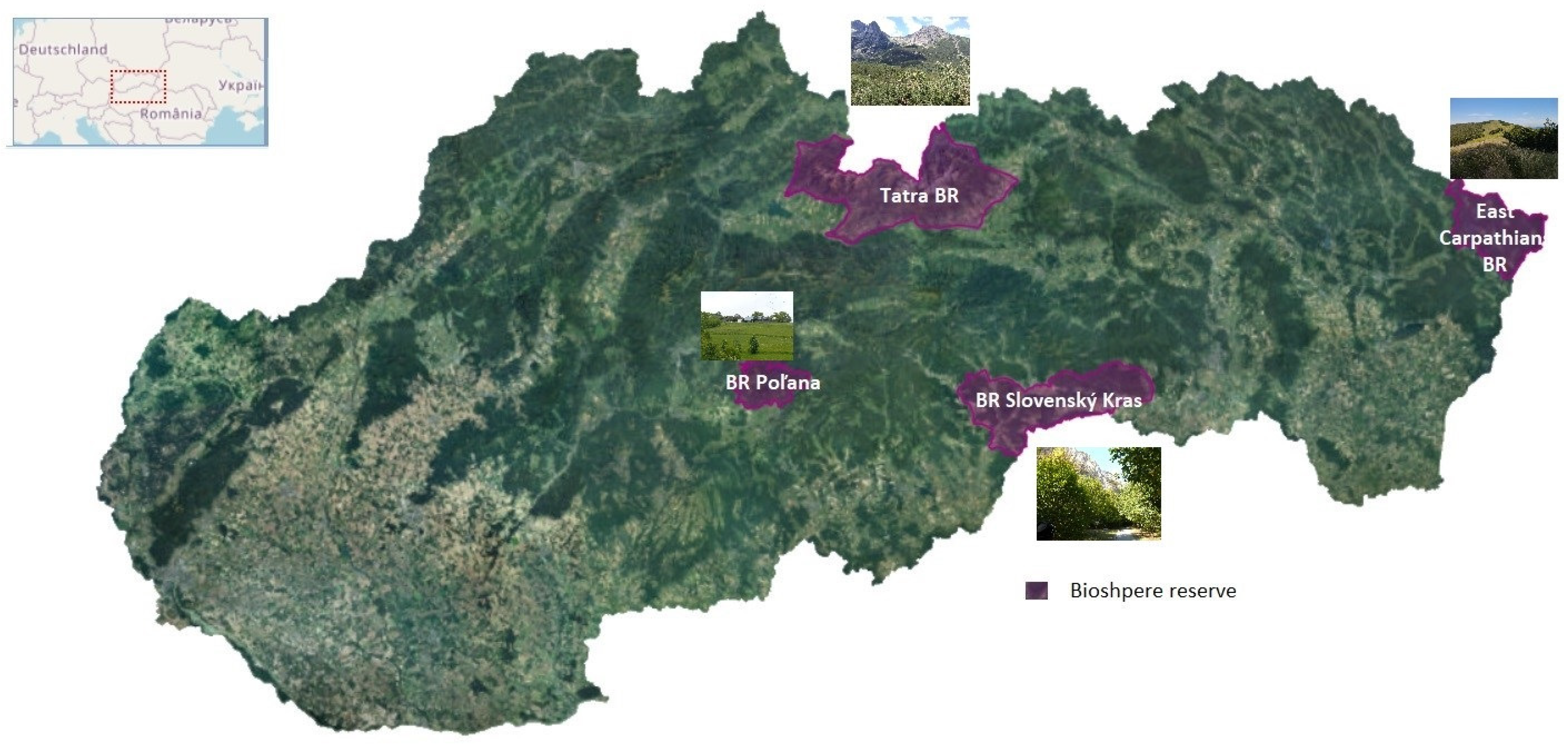The Contribution of Scientists to the Research in Biosphere Reserves in Slovakia
Abstract
1. Introduction
2. Materials and Methods
2.1. Study Area
2.1.1. Slovensky Kras Biosphere Reserve
2.1.2. Poľana Biosphere Reserve
2.1.3. Tatra Transboundary Biosphere Reserve, Poland/Slovakia
2.1.4. East Carpathians Transboundary Biosphere Reserve, Poland/Slovakia/Ukraine
2.2. Methods
3. Review of Research in Biosphere Reserves in Slovakia
3.1. Review of Scientific Studies
3.2. Specifics and Peculiarities of Individual BR
3.2.1. Peculiarities of Research in Slovenský Kras BR
3.2.2. Peculiarities of Research in BR Poľana
3.2.3. Peculiarities of Research in Tatra Transboundary BR
3.2.4. Peculiarities of Research in East Carpathians Transboundary BR
3.3. SWOT
4. Discussion
5. Conclusions
Author Contributions
Funding
Institutional Review Board Statement
Informed Consent Statement
Data Availability Statement
Conflicts of Interest
References
- UNESCO a UNEP. Programme on Man and the Biosphere (MAB). Task Force on: Criteria and Guidelines for the Choice and Establishment of Biosphere Reserves; Final Report; UNESCO a UNEP: Paris, France, 1974. [Google Scholar]
- UNESCO. Biosphere Reserves. UNESCO. 8 October 2019. Available online: https://en.unesco.org/biosphere (accessed on 12 January 2023).
- Voloscuk, I. Ecological and environmental problems in the Tatry Biosphere Reserve. Ekol. Bratisl. 2001, 20, 68–75. [Google Scholar]
- Ferreira, A.F.; Zimmermann, H.; Santos, R.; Von Wehrden, H. Biosphere Reserves’ Management Effectiveness—A Systematic Literature Review and a Research Agenda. Sustainability 2020, 12, 5497. [Google Scholar] [CrossRef]
- Janák, M.; Černecký, J.; Saxa, A. (Eds.) Monitoring of Animals of European Importance in the Slovak Republic. Results and Evaluation Results of Monitoring in 2013–2015. (In Slovak: Monitoring Živočíchov Európskeho Významu v SLOVENSKEJ Republike. Výsledky a Hodnotenie za Roky 2013–2015.); Štátna ochrana prírody Slovenskej Republiky: Banská Bystrica, Slovakia, 2015; Available online: https://www.biomonitoring.sk/CMS/Publication/Detail/35 (accessed on 12 January 2023).
- Stanová, V.Š.; Galvánková, J.; Rizman, I. (Eds.) Monitoring of Plants and Habitats of European Importance in the Slovak Republic. Results and Assessment of Monitoring Results in the Years 2013–2015. (In Slovak: Monitoring Rastlín a Biotopov Európskeho Významu v SLOVENSKEJ Republike. Výsledky a Hodnotenie za roky 2013–2015.); Štátna Ochrana Prírody Slovenskej republiky: Banská Bystrica, Slovakia, 2015.
- ÚGKU SR, “Map Portal. ZBGIS. Version 4.11”. 2021. Available online: https://zbgis.skgeodesy.sk/mkzbgis/sk/zakladna-mapa (accessed on 8 March 2022).
- SOP SR, “Maps of State Nature Conservancy”. Available online: https://maps.sopsr.sk/ (accessed on 18 February 2023).
- Document Search—Web of Science Core Collection. 2002. Available online: https://www.webofscience.com/wos/woscc/basic-search (accessed on 12 June 2022).
- O’Dea, R.E.; Lagisz, M.; Jennions, M.D.; Koricheva, J.; Noble, D.W.; Parker, T.H.; Gurevitch, J.; Page, M.J.; Stewart, G.; Moher, D.; et al. Preferred reporting items for systematic reviews and meta-analyses in ecology and evolutionary biology: A PRISMA extension. Biol. Rev. 2021, 96, 1695–1722. [Google Scholar] [CrossRef] [PubMed]
- Hudec, I.; Kosel, V.; Rozloznik, M. Human impacts on eutrophication and extinction of Jastericie Lake (Biosphere Reserve Slovak Karst). Ekol. Bratisl. 1995, 14, 459–466. [Google Scholar]
- Ahmed, Y.A.-R.; Pichler, V.; Homolák, M.; Gömöryová, E.; Nagy, D.; Pichlerová, M.; Gregor, J. High organic carbon stock in a karstic soil of the Middle-European Forest Province persists after centuries-long agroforestry management. Eur. J. For. Res. 2012, 131, 1669–1680. [Google Scholar] [CrossRef]
- Botos, I.B.-K.C. Landscape-ecological problems in Aggtelek National Park with special regard to sustainable silviculture. Ekol. Bratisl. 2001, 20, 151–156. [Google Scholar]
- Barančok, P. Karst lakes of the Protected Landscape Area—Biosphere Reserve Slovensky kras karst and Aggtelek National Park. Ekol. Bratisl. 2001, 20, 157–190. [Google Scholar]
- Haberova, I. Protection of phytogene pool of Biosphere Reserve Slovak Karst. Ekol. Bratisl. 1995, 14, 427–431. [Google Scholar]
- Krno, I. Ecological factors influence on stoneflies distribution in various river basins of the Slovensky kras (Karst) mountain range biosphere reserve. Ekol. Bratisl. 1996, 15, 261–281. [Google Scholar]
- Majzlan, O. Socions of soil weevils (Coleoptera, Curculionidae) in different vegetation types of Slovensky kras Mts. Ekol. Bratisl. 1995, 14, 19–27. [Google Scholar]
- Liptak, R.M.J. Erosion and reforestation of abandoned lands in the Slovak Karst Biosphere Reserve. Ekol. Bratisl. 1995, 14, 111–124. [Google Scholar]
- Hribik, M.; Vida, T.; Skvarenina, J.; Skvareninova, J.; Ivan, L. Hydrological effects of Norway spruce and European beech on snow cover in a mid-mountain region of the Polana mts., Slovakia/Hydrologický vplyv smreka obyčajného a buka lesného na snehovú pokrývku v stredohorských polohách pohoria poľana na slovensku. J. Hydrol. Hydromech. 2012, 60, 319–332. [Google Scholar] [CrossRef]
- Šatala, T.; Tesař, M.; Hanzelová, M.; Bartík, M.; Šípek, V.; Škvarenina, J.; Minďáš, J.; Waldhauserová, D.P. Influence of beech and spruce sub-montane forests on snow cover in Poľana Biosphere Reserve. Biologia 2017, 72, 854–861. [Google Scholar] [CrossRef]
- Strelcova, K.; Matejka, F.; Kucera, J. Beech stand transpiration assessment—Two methodical approaches. Ekol. Bratisl. 2004, 23, 147–162. [Google Scholar]
- Gömöryová, E.; Střelcová, K.; Škvarenina, J.; Gömöry, D. Responses of soil microorganisms and water content in forest floor horizons to environmental factors. Eur. J. Soil Biol. 2013, 55, 71–76. [Google Scholar] [CrossRef]
- Hríbik, M.; Majlingová, A.; Škvarenina, J.; Kyselová, D. Winter Snow Supply in Small Mountain Watershed as a Potential Hazard of Spring Flood Formation. Bioclimatol. Nat. Hazards 2009, 119–128. [Google Scholar] [CrossRef]
- Mikloš, M.; Vyskot, I.; Šatala, T.; Korísteková, K.; Jančo, M.; Škvarenina, J. Effect of Forest Ecosystems on the Snow Water Equivalent in Relation to Aspect and Elevation in the Hučava River Watershed, Poľana Biosphere Reserve (Slovakia). Ekologia 2017, 36, 268–280. [Google Scholar] [CrossRef]
- Střelcová, K.; Minďáš, J.; Škvarenina, J. Influence of tree transpiration on mass water balance of mixed mountain forests of the West Carpathians. Biologia 2006, 61, S305–S310. [Google Scholar] [CrossRef]
- Ujházy, K.; Ujházyová, M.; Bučinová, K.; Čiliak, M.; Glejdura, S.; Mihál, I. Response of fungal and plant communities to management-induced overstorey changes in montane forests of the Western Carpathians. Eur. J. For. Res. 2018, 137, 169–183. [Google Scholar] [CrossRef]
- Fabriciusová, V.; Kanuch, P.; Kristin, A. Response of Orthoptera assemblages to management of montane grasslands in the Western Carpathians. Biologia 2011, 66, 1127–1133. [Google Scholar] [CrossRef]
- Masný, M.; Weis, K.; Boltižiar, M. Agricultural Abandonment in Chosen Terrain Attributes Context—Case Study from the Poľana Unesco Biosphere Reserve (Central Slovakia). Ekologia 2017, 36, 339–351. [Google Scholar] [CrossRef]
- Rohacek, J. First case of syntopic occurrence of three species of Canthyloscelidae (including Synneuridae) (Diptera). Acta Univ. Carol. Biol. 2006, 50, 105–107. [Google Scholar]
- Sevcik, J. New records of Bolitophilidae, Mycetophilidae, Anisopodidae and Mycetobiidae (Diptera) from Slovakia. Biologia 2005, 60, 588. [Google Scholar]
- Sevcik, J. Neuroptera, Raphidioptera and Mecoptera from Polana Biosphere Reserve of UNESCO (central Slovakia). Cas. Slez. Zemskeho Muz. Ser. A Vedy Prir. 2009, 58, 89–93. [Google Scholar]
- Gömöryová, E.; Hrivnák, R.; Janišová, M.; Ujházy, K.; Gömöry, D. Changes of the functional diversity of soil microbial community during the colonization of abandoned grassland by a forest. Appl. Soil Ecol. 2009, 43, 191–199. [Google Scholar] [CrossRef]
- Ujhazy, R.H.K. Changes of the mountain grassland vegetation after abandonment and colonization by Norway spruce. Ekol. Bratisl. 2005, 24, 231–253. [Google Scholar]
- Wiezik, M.; Technical University in Zvolen; Lepeška, T.; Gallay, I.; Olah, B.; Modranský, J.; Wieziková, A. Wood Pastures in Central Slovakia—Collapse of a Traditional Land Use Form. Acta Sci. Pol. Form. Circumiectus 2018, 4, 109–119. [Google Scholar] [CrossRef]
- Kristin, A.; Hoi, H.; Valera, F.; Hoi, C. The importance of breeding density and breeding synchrony for paternity assurance strategies in the lesser grey shrike. Folia Zool. 2008, 57, 240–250. [Google Scholar]
- Krizova, M.K.E. Rare and endangered taxa of vascular plants in the protected landscape area—Biosphere Reserve Pol’ana. Ekol. Bratisl. 1995, 14, 385–389. [Google Scholar]
- Rudzinski, H.-G. Die Trauermuecken (Diptera: Sciaridae) des Pol’ana Biosphaeren-Reservats (Slovakia). Cas. Slez. Zemskeho Muz. Ser. A Vedy Prir. 2009, 58, 39–46. [Google Scholar]
- Sevcik, J. Faunistic records from Czech Republic and Slovakia—Dixidae. Acta Zool. Univ. Comen. 2007, 47, 253–254. [Google Scholar]
- Celiński, K.; Zbránková, V.; Wojnicka-Półtorak, A.; Chudzińska, E. Biogeography and evolutionary factors determine genetic differentiation of Pinus mugo (Turra) in the Tatra Mountains (Central Europe). J. Mt. Sci. 2015, 12, 549–557. [Google Scholar] [CrossRef]
- Fleischer, P.; Ostrolucka, M.; Ludvova, A. Influence of environmental factors on generative reproductive ability of Picea abies (L.) Karst in the Tatra National Park. Ekol. Bratisl. 2000, 19, 117–124. [Google Scholar]
- Fleischer, M.G.O.P. Pollen vitality monitoring in the Tatra biosphere reserve. Ekol. Bratisl. 1997, 16, 136. [Google Scholar]
- Michal, I.V.I. Natural forest of the Tatra Biosphere Reserve with spruce (Picea excelsa (L.) Karst), Larch (Larix decidua Mill) and ceder pine (Pinus cembra L.). Ekol. Bratisl. 1995, 14, 367–376. [Google Scholar]
- Falťan, V.; Petrovič, F.; Gábor, M.; Šagát, V.; Hruška, M. Mountain Landscape Dynamics after Large Wind and Bark Beetle Disasters and Subsequent Logging—Case Studies from the Carpathians. Remote Sens. 2021, 13, 3873. [Google Scholar] [CrossRef]
- Bytnerowicz, A.; Badea, O.; Barbu, I.; Fleischer, P.; Frączek, W.; Gancz, V.; Godzik, B.; Grodzińska, K.; Grodzki, W.; Karnosky, D.; et al. New international long-term ecological research on air pollution effects on the Carpathian Mountain forests, Central Europe. Environ. Int. 2003, 29, 367–376. [Google Scholar] [CrossRef]
- Koren, M.K.M. Theoretical aspects and principles of the MONTAN project. Ekol. Bratisl. 1995, 14, 149–168. [Google Scholar]
- Das, S.K.; Stefkova, E.; Adhikary, S.P.; Kovacik, L. An updated checklist of algae from the Tatra Mountain lakes (Slovakia)—Based on field research from 2010/12. Phytotaxa 2020, 435, 255–279. [Google Scholar] [CrossRef]
- Komala, Z. Report on some zooplanktonic organisms in the Tatra Lake Toporowy Staw Nizni. Folia Biol. Krakow 1998, 46, 65–68. [Google Scholar]
- Krzan, Z.; Skawinski, P.; Kot, M. Problems of Natural Diversity Protection in the Tatra National Park and Biosphere Reserve. Biodiversity Conservation in Transboundary Protected Areas, Washington. 1996, pp. 120–127. Available online: https://www.webofscience.com/wos/woscc/full-record/WOS:A1996BG62V00016 (accessed on 17 December 2022).
- Bugar, J.H.G. Problems of natural hazard assessment and monitoring in the Tatra Mts. Ekol. Bratisl. 2001, 20, 96–100. [Google Scholar]
- Solarski, M.; Szumny, M. Conditions of spatiotemporal variability of the thickness of the ice cover on lakes in the Tatra Mountains. J. Mt. Sci. 2020, 17, 2369–2386. [Google Scholar] [CrossRef]
- Zielonka, T.; Holeksa, J.; Ciapała, S. A 100-Year History of Floods Determined from Tree Rings in a Small Mountain Stream in the Tatra Mountains, Poland. In Tree Rings and Natural Hazards: A State-of-the-Art; Stoffel, M., Bollschweiler, M., Butler, D.R., Luckman, B.H., Eds.; Springer: Dordrecht, The Netherlands, 2010; Volume 41, pp. 263–275. [Google Scholar] [CrossRef]
- Izakovičová, Z.; Oszlányi, J. Sustainable landscape management of the Tatry Biosphere Reserve of UNESCO. Ekologia 2009, 28, 333–345. [Google Scholar] [CrossRef]
- Švajda, J. Participatory conservation in a post-communist context: The Tatra National Park and Biosphere Reserve, Slovakia. Int. J. Biodivers. Sci. Ecosyst. Serv. Manag. 2008, 4, 200–208. [Google Scholar] [CrossRef] [PubMed]
- Marcis, M.G.M. Sustainable Tourism Development in the Tatra National Park. Ekon. Srod. 2017, 2, 76–86. [Google Scholar]
- Kycko, M.; Zagajewski, B.; Zwijacz-Kozica, M.; Cierniewski, J.; Romanowska, E.; Orłowska, K.; Ochtyra, A.; Jarocińska, A. Assessment of Hyperspectral Remote Sensing for Analyzing the Impact of Human Trampling on Alpine Swards. Mt. Res. Dev. 2017, 37, 66. [Google Scholar] [CrossRef]
- Svajda, J.; Backor, P.; Zahradnik, D.; Banas, M. Number of Tourists as Factor Influencing Trails’ Condition. In Proceedings of the Public Recreation and Landscape Protection—With Man Hand in Hand! Pts 1 and 2, Brno, Czech Republic, 3–5 May 2015; pp. 169–174. Available online: https://www.webofscience.com/wos/woscc/full-record/WOS:000379410300036 (accessed on 17 December 2022).
- Durak, T. Long-term trends in vegetation changes of managed versus unmanaged Eastern Carpathian beech forests. For. Ecol. Manag. 2010, 260, 1333–1344. [Google Scholar] [CrossRef]
- Durak, T.; Durak, R.; Węgrzyn, E.; Leniowski, K. The Impact of Changes in Species Richness and Species Replacement on Patterns of Taxonomic Homogenization in the Carpathian Forest Ecosystems. Forests 2015, 6, 4391–4402. [Google Scholar] [CrossRef]
- Grodzińska, K.; Godzik, B.; Frączek, W.; Badea, O.; Oszlányi, J.; Postelnicu, D.; Shparyk, Y. Vegetation of the selected forest stands and land use in the Carpathian Mountains. Environ. Pollut. 2004, 130, 17–32. [Google Scholar] [CrossRef]
- Schejbalova, J.H.H. The dynamics of selected soil properties over 60 years in natural forest ecosystems: General tendencies and internal dynamics. Ekol. Bratisl. 2004, 23, 66–79. [Google Scholar]
- Olah, B.; Boltiziar, M.; Petrovic, F. Land use changes’ relation to georelief and distance in the East Carpathians Biosphere Reserve. Ekologia 2006, 25, 68–81. [Google Scholar]
- Halada, Ľ.; David, S.; Hreško, J.; Klimantová, A.; Bača, A.; Rusňák, T.; Buraľ, M.; Vadel, Ľ. Changes in grassland management and plant diversity in a marginal region of the Carpathian Mts. in 1999–2015. Sci. Total Environ. 2017, 609, 896–905. [Google Scholar] [CrossRef] [PubMed]
- Bural, H.R.M. Grasslands of the East Carpathian Biosphere Reserve in Slovakia. In Biodiversity Conservation in Transboundary Protected Areas; National Academies Press: Washington, DC, USA, 1996; pp. 233–236. Available online: https://www.webofscience.com/wos/alldb/full-record/WOS:A1996BG62V00033 (accessed on 17 December 2022).
- Dzhagan, V.; Taras Shevchenko National University of Kyiv; Shcherbakova, Y.; Sniezhyk, A. State Scientific Research Expert-Forensic Centre of the Ministry of Internal Affairs of Ukraine A new record of the rare fungus Peziza saniosa (Pezizales, Ascomycota) in Ukraine. Ukr. Bot. J. 2020, 77, 204–209. [Google Scholar] [CrossRef]
- Jurickova, L.; Lozek, V.; Cejka, T.; Dvorak, L.; Horsák, M.; Hrabáková, M.; Míkovcová, A.; Steffek, J. Molluscs of the Bukovske Vrchy Mts. in the Slovakian part of the Vychodne Karpaty Biosphere Reserve. Folia Malacol. 2006, 14, 203–215. [Google Scholar] [CrossRef]
- Pišút, I.; Lackovičová, A.; Guttová, A.; Palice, Z. New lichen records from Bukovské vrchy Mts (NE Slovakia). Acta Mycol. 2013, 42, 267–280. [Google Scholar] [CrossRef]
- Petrovic, P.B.F. Agriculture, landscape, biodiversity: Scenarios and stakeholder perceptions in the Poloniny National Park (NE Slovakia). Ekologia 2006, 25, 82–93. [Google Scholar]
- Bezáková, M.; Bezák, P. Which sustainability objectives are difficult to achieve? The mid-term evaluation of predicted scenarios in remote mountain agricultural landscapes in Slovakia. Land Use Policy 2022, 115, 106020. [Google Scholar] [CrossRef]
- Soliva, R.; Rønningen, K.; Bella, I.; Bezak, P.; Cooper, T.; Flø, B.E.; Marty, P.; Potter, C. Envisioning upland futures: Stakeholder responses to scenarios for Europe’s mountain landscapes. J. Rural. Stud. 2008, 24, 56–71. [Google Scholar] [CrossRef]
- Bezák, P.; Halada, L. Sustainable Management Recommendations to Reduce the Loss of Agricultural Biodiversity in the Mountain Regions of NE Slovakia. Mt. Res. Dev. 2010, 30, 192–204. [Google Scholar] [CrossRef]
- Taggart-Hodge, T.D.; Schoon, M. The challenges and opportunities of transboundary cooperation through the lens of the East Carpathians Biosphere Reserve. Ecol. Soc. 2016, 21, 29. [Google Scholar] [CrossRef]
- Angelstam, P.; Manton, M.; Elbakidze, M.; Sijtsma, F.; Adamescu, M.C.; Avni, N.; Beja, P.; Bezak, P.; Zyablikova, I.; Cruz, F.; et al. LTSER platforms as a place-based transdisciplinary research infrastructure: Learning landscape approach through evaluation. Landsc. Ecol. 2018, 34, 1461–1484. [Google Scholar] [CrossRef]
- Mendis-Millard, S.; Reed, M.G. Understanding Community Capacity Using Adaptive and Reflexive Research Practices: Lessons from Two Canadian Biosphere Reserves. Soc. Nat. Resour. 2007, 20, 543–559. [Google Scholar] [CrossRef]
- Evans, S.W. An assessment of land cover change as a source of information for conservation planning in the Vhembe Biosphere Reserve. Appl. Geogr. 2017, 82, 35–47. [Google Scholar] [CrossRef]
- Stringer, L.C.; Fraser, E.; Harris, D.; Lyon, C.; Pereira, L.; Ward, C.; Simelton, E. Adaptation and development pathways for different types of farmers. Environ. Sci. Policy 2020, 104, 174–189. [Google Scholar] [CrossRef]
- Reed, M.G.; Godmaire, H.; Abernethy, P.; Guertin, M.-A. Building a community of practice for sustainability: Strengthening learning and collective action of Canadian biosphere reserves through a national partnership. J. Environ. Manag. 2014, 145, 230–239. [Google Scholar] [CrossRef]
- Moreira-Muñoz, A.; Carvajal, F.; Elórtegui, S.; Rozzi, R. The Chilean biosphere reserves network as a model for sustainability: Challenges towards regenerative development, education, biocultural ethics and eco-social peace. In UNESCO Biosphere Reserves; Routledge: London, UK, 2019. [Google Scholar]
- Pauditšová, E.; Pauditš, P.; Gazzola, P.; Belčáková, I. 5 Case Studies; De Gruyter Open: Warsaw/Berlin, Poland, 2018; pp. 139–208. [Google Scholar] [CrossRef]
- Carcelén, A.P.; Monzonís, N.C.; Martín, A.R.; Méndez, V.G. Promotion of Environmental Education in the Spanish Compulsory Education Curriculum. A Normative Analysis and Review. Sustainability 2021, 13, 2469. [Google Scholar] [CrossRef]
- German MAB National Committee. Full of Life. UNESCO Biosphere Reserves—Model Regions for Sustainable Development. Springer: Berlin/Heidelberg, Germany, 2005. Available online: https://link.springer.com/book/10.1007/b136203 (accessed on 12 January 2023).
- Gazzola, P.; Belčáková, I.; Pauditšová, E. 1 Introduction; De Gruyter Open: Warsaw/Berlin, Poland, 2019; pp. 1–27. [Google Scholar] [CrossRef]
- UNESCO MAB Sevilla + 5 Recommendations for the Establishment and Functioning of Transboundary Biosphere Reserves. 2000.
- Stein, P.H.R. EUROPARC Expertise Exchange Working Group Transfrontier Protected Areas. EUROPARC Federation, European Union, PHARE Programme. 2001. Available online: https://portals.iucn.org/library/node/28637 (accessed on 23 December 2022).
- Kratzer, A. Biosphere Reserves research: A bibliometric analysis. J. Prot. Mt. Areas Res. Manag. 2018, 10, 36–49. [Google Scholar] [CrossRef]




| Slovenský Kras Biosphere Reserve | Poľana | Tatra Transboundary Biosphere Reserve | East Carpathians Transboundary Biosphere Reserve | |
|---|---|---|---|---|
| Year of designation | 1977 | 1990 | 1992 | 1992 |
| National protected area | NP (since 2002, from former PLA) | PLA | NP | NP |
| IBA Slovenský Kras | IBA Poľana | IBA Tatry | IBA Bukovské vrchy | |
| Area | 74,500 ha | 24,158 ha—proposal for extension in 2015 | 134,448 ha, (Core zone—57,211 ha (Poland: 7548 ha—Slovakia: 49,663 ha), Buffer zone of 30,115 ha (Poland: 6371 ha—Slovakia: 23,744 ha); Transition zone—47,122 ha | 208,076 ha |
| (Core zone—8857 ha; Buffer zone—23,395; | (Core zone—1333 ha; Buffer zone—7930 ha; Transition zone—11,097 ha/proposal for extension 16,407 ha) | (Core zone—30,142 ha; Buffer zone—24,757 ha; the Transition zone—153,177 ha) | ||
| Transition zone: 42,248) | ||||
| Development function—main activities | tourism associated with visiting caves; | agriculture, forestry, tourism, and recreation | tourism; forestry | forestry |
| agriculture; | ||||
| mining and processing of raw materials, engineering, and metal industry | ||||
| Socio-economic characteristics | about 47,900 people live in the transition area | almost 22,000 inhabitants have some involvement in the Poľana BR, 3900 of them live permanently in the transition zone | more than 40,000 inhabitants, of which a large majority live on the Slovak side. | 2299 inhabitants (in 2017, a declining trend) |
| Research Subject | Studied Characteristic |
|---|---|
| Target biosphere reserve | BR Slovenský Kras; BR Poľana, Tatra Transboundary BR; East Carpathians Transboundary BR; Several Slovak BR; Slovak BR in an international context (Slovak BR and foreign BR) |
| Study area | 1. A BR or part thereof directly (1A. Core area; 1B. Buffer zone; 1C. Transition zone; 1D. no mention of zones) 2. protected area (PLA or NP, only mention of BR) |
| Study of the relationship between Man and the Biosphere | 1. Yes, directly deals with BR issues, 2. Indirectly (other research topics implemented in BR, or related topics, e.g., changes in land use) 3. Only biodiversity issue |
| Research topic |
|
| Research aspects | EN—Environmental; EO—Ecological; EC—Economic; SO—Social |
| Message/added value, strength | Open question |
| Weakness, conflicts of interest | Open question |
| Recommendation for management and sustainable development of BR | Open question |
| Comments | Open question |
| Studied Aspect | No of Studies |
|---|---|
| EN | 2 |
| EN, EO, SO | 22 |
| EN, EO, EC, SO | 1 |
| EN, SO | 7 |
| EO | 74 |
| EO, EC | 2 |
| EO, SO | 11 |
| SO | 1 |
| Strengths | Weaknesses |
|
|
| Opportunities | Threats |
|
|
Disclaimer/Publisher’s Note: The statements, opinions and data contained in all publications are solely those of the individual author(s) and contributor(s) and not of MDPI and/or the editor(s). MDPI and/or the editor(s) disclaim responsibility for any injury to people or property resulting from any ideas, methods, instructions or products referred to in the content. |
© 2023 by the authors. Licensee MDPI, Basel, Switzerland. This article is an open access article distributed under the terms and conditions of the Creative Commons Attribution (CC BY) license (https://creativecommons.org/licenses/by/4.0/).
Share and Cite
Špulerová, J.; Piscová, V.; Matušicová, N. The Contribution of Scientists to the Research in Biosphere Reserves in Slovakia. Land 2023, 12, 537. https://doi.org/10.3390/land12030537
Špulerová J, Piscová V, Matušicová N. The Contribution of Scientists to the Research in Biosphere Reserves in Slovakia. Land. 2023; 12(3):537. https://doi.org/10.3390/land12030537
Chicago/Turabian StyleŠpulerová, Jana, Veronika Piscová, and Noemi Matušicová. 2023. "The Contribution of Scientists to the Research in Biosphere Reserves in Slovakia" Land 12, no. 3: 537. https://doi.org/10.3390/land12030537
APA StyleŠpulerová, J., Piscová, V., & Matušicová, N. (2023). The Contribution of Scientists to the Research in Biosphere Reserves in Slovakia. Land, 12(3), 537. https://doi.org/10.3390/land12030537






